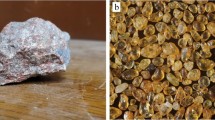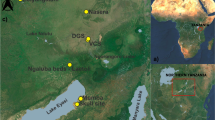Abstract
Fire gilding was the predominant technique for the gilding of metalwork from 300 b.c. in China and 200 a.d. in Europe until the invention of electroplating in the 19th century. This article investigates its metallurgical aspects based on studies of original objects, gilding replication experiments, and literary evidence.
Similar content being viewed by others
References
A. Oddy, Metal Plating and Patination, ed. S. La Niece and P. Craddock (Oxford: Butterworth-Heinemann, 1993), pp. 171–181.
Pliny, Naturalis Historia, 33, chapter 33 (c. 70).
K. Anheuser, D.Phil. thesis, University of Oxford (1996).
P. Northover and K. Anheuser, (paper presented at the Am. Inst. for Conservation Gilded Metals Symposium, St. Paul, MN, June 1995).
B. Cellini, Dell’ Oreficeria, chapter 26 (1568).
Pliny, Naturalis Historia, 33 (c. 70), chapter 64–65. The use of alum for the cleaning of silver is also attested by a fire-gilding recipe in the late 3rd or 4th century Egyptian Leiden Papyrus X, recipe 41. R. Halleux, ed., Les A Ichimistes Grecs, Vol. 1: Leiden Papyrus X, Stockholm Papyrus, Fragments (Paris: Les Belles Lettres, 1981).
O. Untracht, Jewelry Concepts and Technology (New York: Doubleday, 1985).
M. Chapman, Ancient and Historic Metals, ed. D.A. Scott, J. Podany, and B.B. Considine (Marina del Rey, CA: Getty Conservation Institute, 1994), pp. 229–238.
O. Vittori, Rivista di Archeologia, 2 (1978), pp. 71–81; Gold Bulletin 12 (1979), pp. 35–39.
S. Boucher, Small Bronze Sculpture from the Ancient World, ed. M. True and J. Podany (Malibu, CA: J. Paul Getty Museum, 1990), pp. 161–178.
K. Anheuser, Bulletin of the Metals Museum, 26 (1996), pp. 47–51.
T.B. Massalski, ed., Binary Alloy Phase Diagrams, 2nd edition (Materials Park, Ohio: ASM, 1990).
J. Twilley, The Ceramics Cultural Heritage, ed. P. Vicenzini (Faenza: Techna, 1995), pp. 161–173.
P. Dandridge, Metropolitan Museum, New York, personal communication, June 1995.
E.C. Bunker et al., Outils et ateliers d’orfevres des temps anciens, Antiquites Nationales Memoire 2, ed. Christiane Eluere (St. Germain-en-Laye: Musee des Antiquites Nationales, 1993), pp. 55–66.
S. Stenbeck, Zeitschrift fur anorganische und allgemeine Chemie, 214 (1933), pp. 16–26.
C. Rolfe and W. Hume-Rothery, Journal of the Less-Common Metals, 13 (1967), pp. 1–10.
H. Lechtman, Science and Archaeology, ed. R.H. Brill (Cambridge, MA: MIT Press, 1971), pp. 2–30.
A. Oddy, Aspects of Early Metallurgy, British Museum occasional paper no. 17, ed. A. Oddy (London: British Museum, 1980), pp. 129–134.
T. Phillipps, Archaeologia, 32 (1847), pp. 183–244. See also C.S. Smith and J.G. Hawthome, Transactions of the American Philosophical Society, New Series, 64 (4) (1974), pp. 3–128. (For fire-gilding see recipes 55 and 219).
C.S. Smith and M. Teach Gnudi, eds., The Pirotechnia of Vannoccio Biringaccio, Book IX, chapter 4 (New York: Dover, 1990). English translation only.
M.M. Mango and A. Bennett, Journal of Roman Archaeology Supplementary Series, 12 (1994).
A.C. Gunter and P. Jett, Ancient Iranian Metalwork in the Arthur M. Sackler Gallery and the Freer Gallery of Art (Washington, D.C.: Freer & Sackler Galleries, 1992), p. 36.
M. Berthelot and C.-E. Ruelle, eds., Collections des Anciens A Ichimistes Grecs, 3 volumes, 1888 (Osnabruck: Otto Zeller, 1967). For stopping-out pastes see book VI, recipes 21, 23, and 29. Further recipes are given in Cellini’s Dells Oreficeria, chapter 33.
A. Oddy et al., Small Bronze Sculpture from the Ancient World, ed. M. True and J. Podany (Malibu, CA: J. Paul Getty Museum, 1990), pp. 103–124.
S.F. Moran, Artibus Asiae, 31 (1969), pp. 55–65.
A. Oddy, S. La Niece, and N. Stratford, Romanesque Metalwork: Copper Alloys and Their Decoration (London: British Museum, 1986).
C.R. Dodwell, ed., Theophilus: de diaersis artibus, The Various Arts, 1st Edition (London: Thomas Nelson, 1961).
P. Jett, Metal Plating and Patination, ed. S. La Niece and P. Craddock (Oxford: Butterworth-Heinemann, 1993), pp. 193–200.
P. Jett and J.G. Douglas, Materials Research Society Symposium Proceedings, vol. 267 (Pittsburgh, PA: MRS, 1992), pp. 205–223.
M.J. Hughes, J.P. Northover, and B.E.P. Staniaszek, Oxford Journal of Archaeology, 1 (1982), pp. 359–364.
M. Ratka and P. Sahm, (paper presented at the 13th International Bronze Congress, Harvard, 28th May–1st June 1996). and M. Ratka and P. Sahm, Der betende Knabe, Original und Rekonstruktion, ed. G. Zimmer and N. Hacklander (Frankfurt: Peter Lang), pp. 67–80.
A. Oddy, MASCA Journal, 2 (1982), pp. 45–47.
Author information
Authors and Affiliations
Additional information
Author’s Note: All compositions are in weight percent. The artifact appearing on this page is a 6th–7th century Anglo-Saxon cruciform brooch of fire-gilded low-tin bronze. A fire-gilded copper Chinese garment hook with a turquoise inlay from c. 200 b.c. is shown on page 60; three Chinese garment hooks of fire-gilded and silvered copper with turquoise in lay appear on page 61.
Fore more information, contact K. Anheuser, Staatliche Museen Berlin, Schlosstr. la, D-14059, Berlin, Germany, telephone 49-30-320-91-298; fax +49-30-322-16-14.
Rights and permissions
About this article
Cite this article
Anheuser, K. The practice and characterization of historic fire gilding techniques. JOM 49, 58–62 (1997). https://doi.org/10.1007/s11837-997-0015-6
Issue Date:
DOI: https://doi.org/10.1007/s11837-997-0015-6




